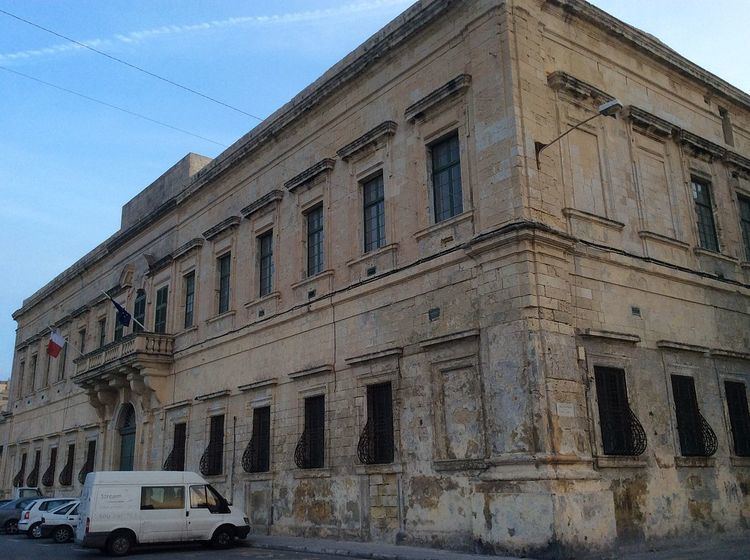Former names Palazzo Carniero Floors 2 | Status Intact Architectural style Mannerism Opened 1696 Phone +356 2295 3230 | |
 | ||
Current tenants Government Property Department Similar Auberge d'Aragon, Auberge de Provence, Auberge de France, Auberge d'Italie, Auberge d'Angleterre | ||
Auberge de bavi re
The Auberge de Bavière (Maltese: Berġa tal-Baviera) is a palace in Valletta, Malta. It was built as Palazzo Carniero in 1696, and it was the residence of Grand Master Marc'Antonio Zondadari in the early 18th century. In 1784, it was converted into the auberge for the Anglo-Bavarian langue of the Order of Saint John, and it remained so until the French occupation of Malta in 1798.
Contents
It was used by the British military in the 19th and early 20th centuries, briefly housing a military hospital in World War I. It was subsequently used as a school, a hostel for bombed-out people in World War II, and it was also used by a number of government agencies. Since 1997, it has been the main offices of the Government Property Department.
The palace is located in the northern part of Valletta, near the English Curtain and the Jews' Sally Port. It overlooks St. Elmo Bay and the entrance of Marsamxett Harbour. The surrounding neighbourhood is popularly known as il-Baviera after the auberge.
History
Palazzo Carniero was built in 1696 by the Portuguese Balì Fra Gaspare Carniero on a site where a lime kiln had stood. The building was designed by the Maltese architect Carlo Gimach, who was a personal friend of Carniero. The building was one of the last examples of austere and staid architecture in the 17th century, before the much more ornate Baroque style became more popular.
The site was rented for 31 scudi per year for the term of his life and that of one other person nominated by him, and thereafter reverted to the common treasury. The palace was the residence of Grand Master Marc'Antonio Zondadari from 1702 until his death in 1722. In 1725 Grand Master de Vilhena was symbolically given a sword and a hat, known officially as 'stoc' and 'piliet', similar to other heads of European powers by Pope Benedict XII. For this occasion on 19 April 1725 the papacy sent its Papal Legate, Monsignior Giovanni Francesco Abbate Olivieri. The Grand Master made large ceremonies for this occasion, and embellished Palazzo Carniero with the finest settings to receive the Papal Legate.
In December 1782 the Elector of Bavaria, through Gaetano Bruno, bought the palazzo for 20000 scudi and it began to be used by the newly formed Anglo-Bavarian Langue which was instituted by Grand Master Emmanuel de Rohan-Polduc two years later in 1784. The building remained an auberge until the Order was expelled from the island with the French occupation of Malta in 1798.
The auberge was handed to the British military authorities in 1824, and it was used as an officers' mess and later the Command Paymaster's headquarters. On 15 June 1915 it opened as the Bavière Hospital, treating British military personnel injured in World War I, and specializing in severe cases in need of surgery, including head and spine injuries. The hospital initially had 100 beds, but these were later increased to 155. It closed on 14 August 1917, and the building was handed over to the civilian authorities in 1921. The building was included on the Antiquities List of 1925 together with the other auberges in Valletta.
In World War II, the palace was converted into a hostel for people whose homes were destroyed by aerial bombardment. The building suffered minor damage in the war, but it was repaired and by the 1960s it became a government school. The Land Directorate occupied the building from 1979 to 1997, when it was given to the Government Property Department. The palace was rehabilitated and restored in 2001.
The auberge is a Grade 1 national monument, and it is also listed on the National Inventory of the Cultural Property of the Maltese Islands.
Architecture
Auberge de Bavière is a large two-story building. It has an austere façade containing a centrepiece with the main doorway, above which is an open stone balcony. Six rectangular windows decorated with mouldings flank either side of the centrepiece. The corners of the building have large pilasters, and a cornice runs along the entire building. A courtyard is located at the rear of the building, an unusual feature since at the time courtyards were usually placed at the centre.
Commemorative coins
Auberge de Bavière was depicted on two commemorative coins minted in 2015 by the Central Bank of Malta. The coins show the auberge's façade on the reverse and the coat of arms of Malta on the obverse.
